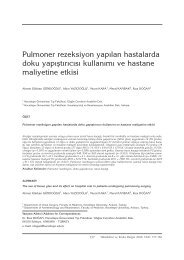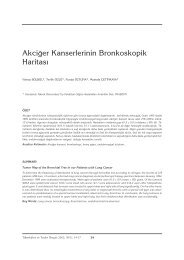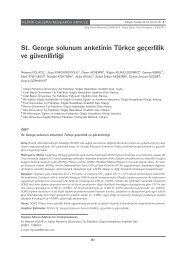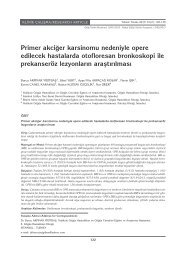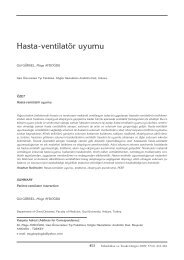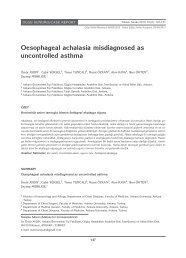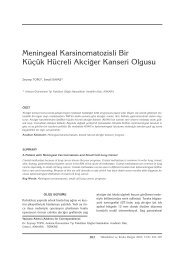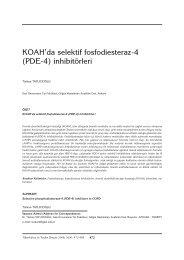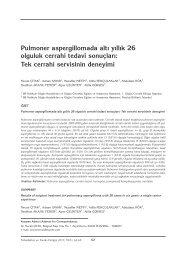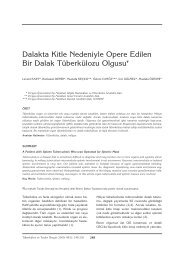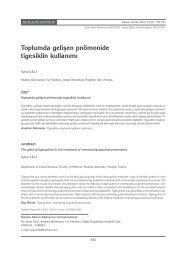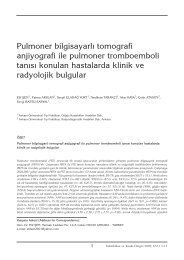273-276 endorbonchial - Tuberkuloz ve Toraks Dergisi
273-276 endorbonchial - Tuberkuloz ve Toraks Dergisi
273-276 endorbonchial - Tuberkuloz ve Toraks Dergisi
Create successful ePaper yourself
Turn your PDF publications into a flip-book with our unique Google optimized e-Paper software.
Endobronchial hamartoma remo<strong>ve</strong>d by<br />
flexible fiberoptic bronchoscopy via<br />
electrocautery<br />
Selda KAYA 1 , Ayşegül KARALEZLİ 1 , Erkan BALKAN 2 , Ece ÇAKIROĞLU 3 , H. Canan HASANOĞLU 1<br />
1<br />
Ankara Atatürk Eğitim <strong>ve</strong> Araştırma Hastanesi, Göğüs Hastalıkları Kliniği,<br />
2 Ankara Atatürk Eğitim <strong>ve</strong> Araştırma Hastanesi, Göğüs Cerrahisi,<br />
3 Ankara Atatürk Eğitim <strong>ve</strong> Araştırma Hastanesi, Patoloji Kliniği, Ankara.<br />
ÖZET<br />
Fleksibl bronkoskopi ile elektrokoter yoluyla tedavi edilen endobronşiyal hamartom olgusu<br />
Hamartom en sık görülen benign akciğer tümörüdür. Sıklıkla soliter nodül <strong>ve</strong>ya endobronşiyal lezyon olarak periferde<br />
parankimde görülür. Endobronşiyal formu hava yolu obstrüksiyonu, atelektazi <strong>ve</strong> tekrarlayan pnömoniye neden olur.<br />
Endobronşiyal hamartomlar cerrahi rezeksiyonla <strong>ve</strong>ya bronkoskopik olarak çıkarılabilir. Biz cerrahi rezeksiyon gerekmeden<br />
bronkoskopik elektrokoterle tedavi ettiğimiz endobronşiyal hamartom olgusunu sunuyoruz.<br />
Anahtar Kelimeler: Hamartom, elektrokoter, bronkoskopi.<br />
SUMMARY<br />
Endobronchial hamartoma remo<strong>ve</strong>d by flexible fiberoptic bronchoscopy via electrocautery<br />
Selda KAYA 1 , Ayşegül KARALEZLİ 1 , Erkan BALKAN 2 , Ece ÇAKIROĞLU 3 , H. Canan HASANOĞLU 1<br />
1 Department of Pulmonary Medicine, Ankara Atatürk Training and Research Hospital, Ankara, Turkey,<br />
2 Department of Thoracic Surgery,Ankara Atatürk Training and Research Hospital, Ankara, Turkey,<br />
3 Department of Pathology, Ankara Atatürk Training and Research Hospital, Ankara, Turkey.<br />
Yazışma Adresi (Address for Correspondence):<br />
Dr. Selda KAYA, Ankara Atatürk Eğitim <strong>ve</strong> Araştırma Hastanesi, Göğüs Hastalıkları Kliniği,<br />
Bilkent, ANKARA - TURKEY<br />
e-mail: seldakaya@turk.net<br />
<strong>273</strong> Tüberküloz <strong>ve</strong> <strong>Toraks</strong> <strong>Dergisi</strong> 2006; 54(3): <strong>273</strong>-<strong>276</strong>
Endobronchial hamartoma remo<strong>ve</strong>d by flexible fiberoptic bronchoscopy via electrocautery<br />
Hamartomas are the most common benign tumors of the lung. It is most common periferally in the parenchyma as solitary<br />
nodule or endobronchial lesion. Endobronchial form may cause obstruction of airway, atelectasis and recurrent pneumonia.<br />
Endobronchial hamartomas may be treated by surgical inter<strong>ve</strong>ntion or bronchoscopic excision (with rigid or flexible<br />
procedures). We are presenting a case of endobronchial hamartoma succesfully treated with bronchoscopic electrocautery<br />
without a need for surgical removal.<br />
Key Words: Hamartoma, electrocautery, flexible fiberoptic bronchoscopy.<br />
Hamartomas of the lungs are benign mesenchymatous<br />
cartilage containing tumors. There are<br />
two clinical type of hamartomas as location of lesions:<br />
intraparenchymal or intrabronchial. Parenchymal<br />
hamartomas are usually asymptomatic<br />
and present radiologically as a coin lesion.<br />
Symptoms of intrabronchial form arise from<br />
obstruction of tracheobronchial lumen (1-4). We<br />
are presenting a case of endobronchial hamartoma<br />
succesfully treated with bronchoscopic electrocautery<br />
without a need for surgical removal.<br />
CASE REPORT<br />
A se<strong>ve</strong>nty-nine years old man was admitted to<br />
the hospital with the complaints of cough, progressi<strong>ve</strong><br />
shortness of breath, and consciousness.<br />
He had a diagnosis of COPD for 20 years and<br />
had also recurrent episodes of pneumonia. He<br />
had a history of tuberculosis. On admission, the<br />
patient was dyspneic, and had a subfebrile fe<strong>ve</strong>r,<br />
his blood pressure was measured as 150/90<br />
mmHg. Physical examination of the chest re<strong>ve</strong>aled<br />
decreased <strong>ve</strong>ntilation of the right lower field<br />
and rhonchi thoroughout the lungs. He had clubbing<br />
that might be related with his recurrent episodes<br />
of pneumonia history. Blood gas analysis<br />
showed respiratory asidosis. He needed for 24<br />
hour mechanical <strong>ve</strong>ntilation. Blood tests were<br />
re<strong>ve</strong>aled only leucocytosis (predominantly blood<br />
neutrophilia). The chest X-ray showed an<br />
atelectasis of the right lower lobe, bilateral pleural<br />
effusion and cardiomegaly (Figure 1). Left<br />
<strong>ve</strong>ntricular hypertrophy, a mild aortic val<strong>ve</strong> stenosis<br />
and pulmonary hypertension (75 mmHg)<br />
was reported in his echocardiography. Pleural<br />
thoracentesis re<strong>ve</strong>aled a transudati<strong>ve</strong> effusion.<br />
Computerized tomography of the chest showed<br />
bilateral pleural effusion (massi<strong>ve</strong> in the right hemithorax),<br />
atelectasis of the right lower lobe, endobronchial<br />
lesion in the middle lobe (Figure 2).<br />
Tüberküloz <strong>ve</strong> <strong>Toraks</strong> <strong>Dergisi</strong> 2006; 54(3): <strong>273</strong>-<strong>276</strong><br />
274<br />
Figure 1. Chest X-ray: Atelectasis of the right lower<br />
lobe, bilateral pleural effusion and cardiomegaly.<br />
Figure 2. The view of thorax CT: Bilateral pleural effusion<br />
(massi<strong>ve</strong> in the right hemithorax), atelectasis<br />
of the right lower lobe, endobronchial lesion in the<br />
middle lobe.<br />
Flexible bronchoscopy under local anaesthesis<br />
re<strong>ve</strong>aled a yellowish, smooth shining surface<br />
with a wide sessile base polypoid lesion which<br />
was partially occluding the bronchus intermedius<br />
(Figure 3). We considered macroscopically<br />
endobronchial hamartoma. We remo<strong>ve</strong>d it by<br />
flexible bronchoscopic bascet type forceps via<br />
electrocautery. Microscopic examination of the
enkli...<br />
Figure 3. The view of FOB: A yellowish, smooth shining<br />
surface with a wide sessile base polypoid lesion<br />
which was partially occluding the bronchus intermedius.<br />
endobronchial lesion re<strong>ve</strong>aled a benign, nonchondromatous,<br />
mesenchymal proliferation predominantly<br />
scatterened epitelial lined and<br />
myxomatous fibrous connecti<strong>ve</strong> tissue. Hystologic<br />
examination of the tumor was reported “Hamartomatous<br />
polyp” (Figure 4). After the procedure,<br />
our patient had not any problem, at the<br />
discharge the chest X-ray did not show any pathology.<br />
renkli...<br />
Figure 4. The view of pathologic examination: Benign,<br />
nonchondromatous, mesenchymal proliferation<br />
predominantly scatterened epitelial lined and myxomatous<br />
fibrous connecti<strong>ve</strong> tissue.<br />
Kaya S, Karalezli A, Balkan E, Çakıroğlu E, Hasanoğlu HC.<br />
DISCUSSION<br />
Endobronchial hamartoma is a benign lesion made<br />
up of elements of lung and bronchus, generally<br />
including cartilaginous, osseous, fatty and muscular<br />
tissue (2). Hamartomas occur as endobronchial<br />
lesion in 10 to 20% of cases, howe<strong>ve</strong>r the<br />
exact incidence is variable as other series report<br />
in only 1.4% of cases (1,2). Symptoms of endobronchial<br />
hamartoma arise from obstruction of the<br />
tracheobronchial lumen, e.g fe<strong>ve</strong>r, hemoptysis,<br />
cough, purulent expectoration, wheezing, pleural<br />
pain and respiratory distress (3). Atelectasis and<br />
recurrent pneumonitis may be frequently seen clinical<br />
presentations. The diagnosis of endobronchial<br />
hamartoma is easily accomplished by bronchoscopy<br />
with endobronchial biopsy. It is well circumscribed,<br />
yellowish, presenting a smooth shining<br />
surface with a wide sessile base (4-8). Histologic<br />
examination may re<strong>ve</strong>al epitelial, connecti<strong>ve</strong>,<br />
fatty, muscular, osseous and cartilaginous<br />
tissue elements, with cartilage often constituting<br />
the greater part of lesion (3,8).<br />
The traditional treatment of endobronchial hamartoma<br />
is thoracotomy with bronchotomy, lobectomy<br />
or lung resection (3,8). There may be<br />
succesfully treated cases exclusi<strong>ve</strong>ly using rigid<br />
or flexible bronchoscopic techniques (Nd yaser<br />
photocoagulation, or electrocautery, cryotherapy<br />
and photodynamic therapy) thus sparing surgical<br />
inter<strong>ve</strong>ntion (1,4,8). Cheu et al. belie<strong>ve</strong> if the lesion<br />
is not accessible during bronchoscopy, there<br />
would be indicated transpleural bronchotomy as<br />
the treatment of choice for endobronchial hamartoma,<br />
only in cases in which prolonged bronchial<br />
obstruction has produced irre<strong>ve</strong>rsible lung destruction<br />
should the hamartoma be treated with<br />
lung resection (5). Our patient had not any lung<br />
resection and endobronchial hamartoma was accessible<br />
during bronchoscopy. Se<strong>ve</strong>ral reports<br />
show succesfully removal by flexible or rigid<br />
bronchoscopy. We used both of them. Because<br />
there ha<strong>ve</strong> been seen almost recurrency in EHs.<br />
On the other hand the other invazi<strong>ve</strong> procedure<br />
could not be tolerated by our patient. Bronchoscopic<br />
electrocautery is an inexpensi<strong>ve</strong> and simple<br />
technique. Its common application in general<br />
surgery and gastroenterology. Despite the favorable<br />
characteristics, experience with electroca-<br />
275 Tüberküloz <strong>ve</strong> <strong>Toraks</strong> <strong>Dergisi</strong> 2006; 54(3): <strong>273</strong>-<strong>276</strong>
Endobronchial hamartoma remo<strong>ve</strong>d by flexible fiberoptic bronchoscopy via electrocautery<br />
utery in tracheobronchial tree is limited. The extent<br />
of effect of electrocautery stil unknown and<br />
there could be a possible hazard of bronchial wall<br />
perforation. Complications of this procedure are<br />
hemoptysis, perforation and burn on the tracheal<br />
wall (6). Although the other bronchoscopic procedures<br />
can effect much deeper tissue, such as<br />
Nd Yag laser, electrocautery can be used more<br />
safely for the treatment of these endobronchial lesions.<br />
We are thinking that this procedure could<br />
be use in the treatment of an endobronchial lesion,<br />
if polypoid lesion is in the bronchial tree and<br />
accessible. The management of EHs must be individualized<br />
according to the characteristics of<br />
each patient and each hamartoma (2). In the follow-up<br />
period of the patient, he wasn’t any additional<br />
problem and his clinical performance status<br />
was good. Our experience, endoscopic treatment<br />
with bronchoscopic electrocautery is a good<br />
therapeutic choice for symptomatic and selected<br />
patients.<br />
Tüberküloz <strong>ve</strong> <strong>Toraks</strong> <strong>Dergisi</strong> 2006; 54(3): <strong>273</strong>-<strong>276</strong><br />
<strong>276</strong><br />
REFERENCES<br />
1. Altay Şahin A, Aydıner A, Kalyoncu F. Endobronchial<br />
hamartoma remo<strong>ve</strong>d by rigid bronchoscope. Eur Respir<br />
J 1989; 2: 479-80.<br />
2. Cosio GB, Villera V, Esca<strong>ve</strong>-Sustaeta J. Endobronchial<br />
hamartoma. Chest 2002; 122: 202-5.<br />
3. Borro JM, Moya J, Botella A. Endobronchial hamartoma,<br />
report of se<strong>ve</strong>n cases. Scand J Thor Cardiovasc Surg<br />
1989; 23: 285-7.<br />
4. Claudia A. Stey, Peter Vogt, Erich W. Russi. Endobronchial<br />
lipomatous hamartoma, a rare case of bronchial occlusion.<br />
Chest 1998; 113: 254-5.<br />
5. Cheu Maj HW, Grishkin Col B. A, Endobronchial hamartoma<br />
treated by bronchoscopic excision. Southern Medical<br />
Journal 1993; 86 (10): 1164-5.<br />
6. Ton JM, Van Boxem, Westerga J. Tissue effects of Bronchoscopic<br />
electrocautery, bronchoscopic apperance and<br />
histologic changes of bronchial wall after electrocautery.<br />
Chest 2000; 117: 887-91.<br />
7. Verkindre C, Brichet A, Maurage CA. Morphological<br />
changes induced by extensi<strong>ve</strong> endobronchial electrocautery.<br />
Eur Respir J 1999; 14: 796-9.<br />
8. Inmaculada A, Perez-Ronchel J, Reyes N. Endobronchial<br />
hamartoma diagnosed by fleksible bronchoscopy. Journal<br />
of Bronchology 2002; 9: 212-5.



